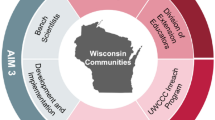Abstract
Background. The National Cancer Institute’s (NCI’s) Cancer Information Service (CIS) Partnership Program involves collaboration with over 900 organizations and coalitions serving minority and medically underserved populations. Cancer Information Service collaborations are categorized into three types: networking, educational program, and program development partnerships.Methods. A survey of CIS partnership organizations (n=288).Results. Most respondents reported that partnerships with CIS are collaborative and make good use of their organization’s skills and resources, and most perceive that the benefits of partnership outweigh any drawbacks, More than one-quarter say partnerships have not done a good job evaluating collaborative activities. Results vary among three types of partnerships.Conclusions. Evaluation of the CIS Partnership Program presents an opportunity to examine how a large-scale and multi-faceted partnership effort has been implemented, how it is evaluated, and initial indicators of program success. Organizations, health professionals, and community leaders interested in effective partnerships can use these findings to strengthen collaborations and maximize outcomes.
Similar content being viewed by others
References
Bright MA. The National Cancer Institute’s Cancer Information Service: A premiere Cancer Information and education resource for the nation. J Cancer Educ. 2007;22 (suppl):S2-S7.
Fleisher L, Kornfeld J, Ter Maat J, et al. Building effective partnerships: a national evaluation of the Cancer Information Service Outreach Program, part 2. J Health Commun. 1998;3 (suppl):21–35.
Kornfeld J, Fleisher L, Ter Maat J, et al. Reaching minority and underserved populations: the impact of the Cancer Information Service’s Outreach Program, part 3. J Health Commun. 1998;3 (suppl):36–48.
Lasker RD, Weiss ES, Miller R. Partnership synergy: a practical framework for studying and strengthening the collaborative advantage. Milbank Q. 2001;79:179–205.
Weiss ES, Anderson RM, Lasker RD. Making the most of collaboration: exploring the relationship between partnership synergy and partnership functioning. Health Educ Behav. 2002;29:683–698.
Kreuter MW, Lezin NA, Young LA. Evaluating community-based collaborative mechanisms: implications for practitioners. Health Promot Pract. 2000;1:49–63.
Lasker RD, Weiss ES. Broadening participation in community problem solving: a multidisciplinary model to support collaborative practice and research. J Urban Health. 2003;80:14–47.
Butterfoss FD, Francisco VT. Evaluating community partnerships and coalitions with practitioners in mind. Health Promot Pract. 2004;5:108–114.
Perrochia R, Galassi A, Jacobs R, et al. The Cancer Information Service staff training program: A foundation for excellence. J Cancer Educ. 2007;22 (suppl):S8-S17
Author information
Authors and Affiliations
Corresponding author
Rights and permissions
About this article
Cite this article
La Porta, M., Hagood, H., Kornfeld, J. et al. Partnership as a means for reaching special populations: Evaluating te NCI’s CIS Partnership Program. J Canc Educ 22 (Suppl 2), S35–S40 (2007). https://doi.org/10.1007/BF03174344
Issue Date:
DOI: https://doi.org/10.1007/BF03174344




